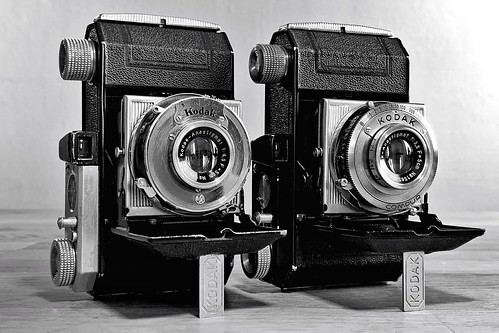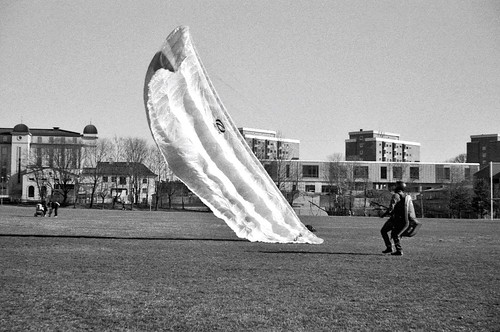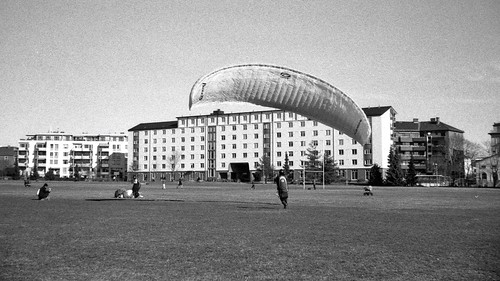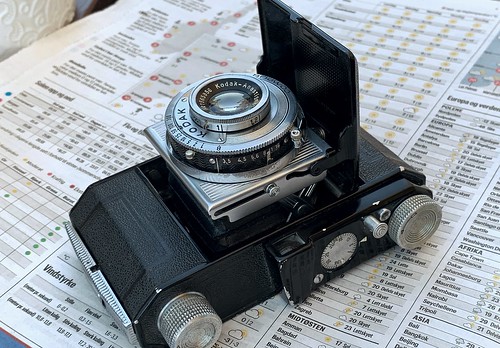The pre-war people's pocket camera
The Retinette models from 1939 was Kodak's budget alternative to the Retinas. It had basically the same design as the concurrent Retina of its time, but there was some cost-cuts on the optics, the focusing mechanism and the shutter. The Retinette type 160 superseded the earlier (and very first Retinette) type 147, which I still don't own.

The two cameras on the main picture shares the same designation, but still got different specs.
The left one has the Kodak-Anastigmat 5cm/4.5 lens in a Gauthier shutter with speeds of 1/25 to 1/125 second plus B. This shutter is weak and flimsy, at least on my copy. I am not shure if a test with film will provide any results worth displaying.
The one on the right got the Kodak-Anastigmat 5cm/3.5 lens in a Compur shutter with speeds from 1 to 1/300 second plus B. On my camera this shutter and lens works very well.
Both these Retinettes are fitted with lenses with front cell focusing, while the Retinas from the same time period is focused with the hole lens unit in a helical mechanism.
Since I am positively biased towards most of the early Retinas, I find the Retinette II easy and fun to use, at least the one with the f3.5 lens and the Compur shutter. It is supposed to have a lesser lens, but I find the results to be on the same quality level as its four elements concurrent. A few things to remember though:
Pros:
Cons:
Verdict:
Classic cameras of this age have their fair share of quirks and limitations. If you accept this, the Retinette II type 160 is a collectible vintage camera that possibly also could serve as an everyday shooter. And it is so good looking too...!
Here is a few sample shots from the Retinette with the f3.5 lens:
The left one has the Kodak-Anastigmat 5cm/4.5 lens in a Gauthier shutter with speeds of 1/25 to 1/125 second plus B. This shutter is weak and flimsy, at least on my copy. I am not shure if a test with film will provide any results worth displaying.
The one on the right got the Kodak-Anastigmat 5cm/3.5 lens in a Compur shutter with speeds from 1 to 1/300 second plus B. On my camera this shutter and lens works very well.
Both these Retinettes are fitted with lenses with front cell focusing, while the Retinas from the same time period is focused with the hole lens unit in a helical mechanism.
Since I am positively biased towards most of the early Retinas, I find the Retinette II easy and fun to use, at least the one with the f3.5 lens and the Compur shutter. It is supposed to have a lesser lens, but I find the results to be on the same quality level as its four elements concurrent. A few things to remember though:
- There is no focusing aid, the distance must be estimated. However, if you are used to zone focusing, this should not be a problem
- The shutter must be cocked separately before shooting. If you forget it, you miss the shot
- This camera model is very robust, but check for light leaks in the bellows. If you buy one, clean it properly for paint flakes, dust and old dirt. Assume that a camera of this age probably need a professional service sooner or later
- The lens is uncoated. This means that the photographer should be careful with shooting against any strong light sources to avoid flare
- And a good advice: Use contrast filter (yellow/orange/red) when shooting b/w film outdoors in daylight. It improves the end result a lot.
Pros:
- A fun, small and easy to use camera that fits in your pocket
- Robust and durable
- A proper vintage camera with a reasonable price tag
Cons:
- Uncoated lenses are prone to flare
- The shutter probably needs service
Verdict:
Classic cameras of this age have their fair share of quirks and limitations. If you accept this, the Retinette II type 160 is a collectible vintage camera that possibly also could serve as an everyday shooter. And it is so good looking too...!




No comments:
Post a Comment